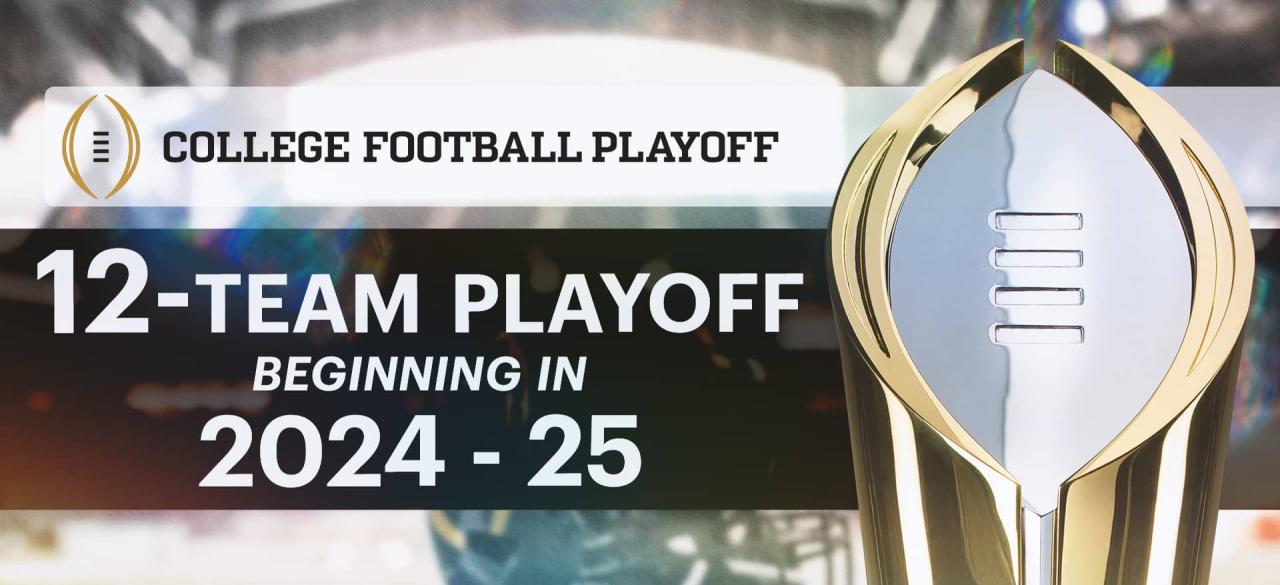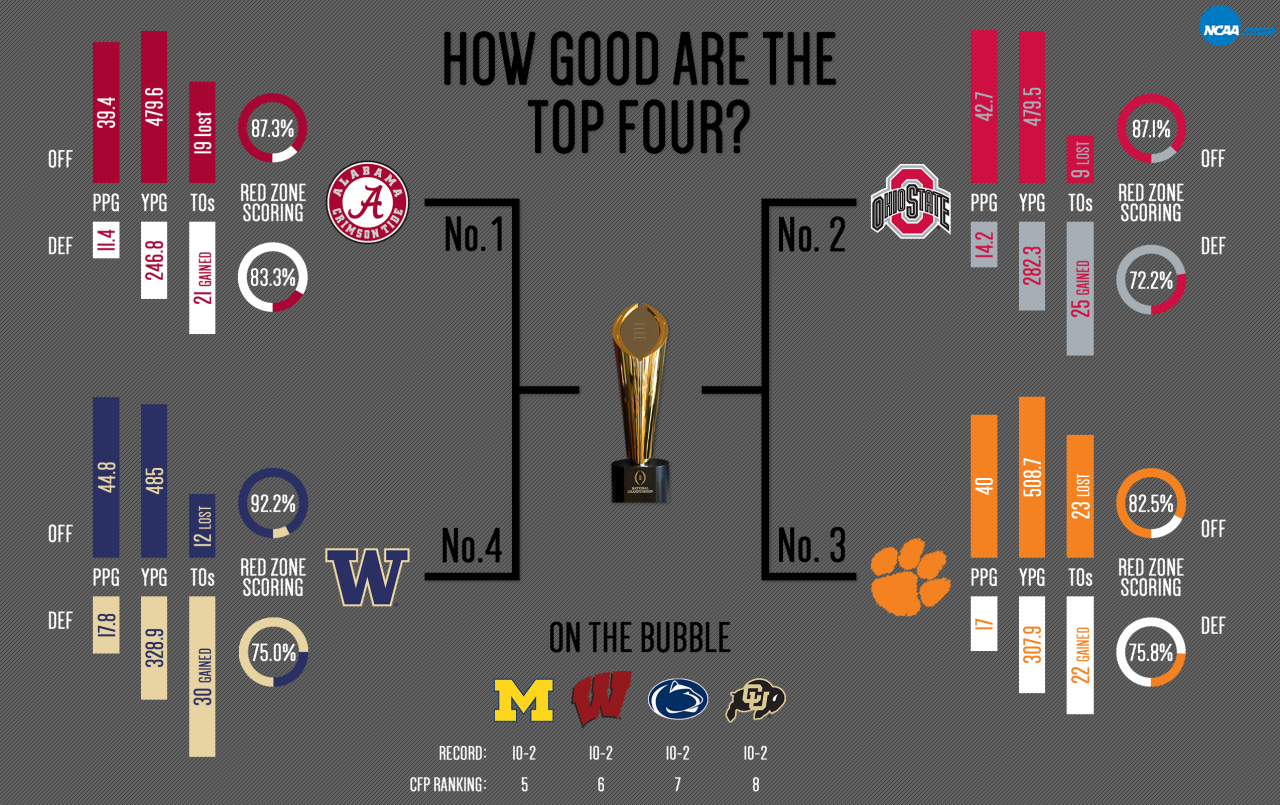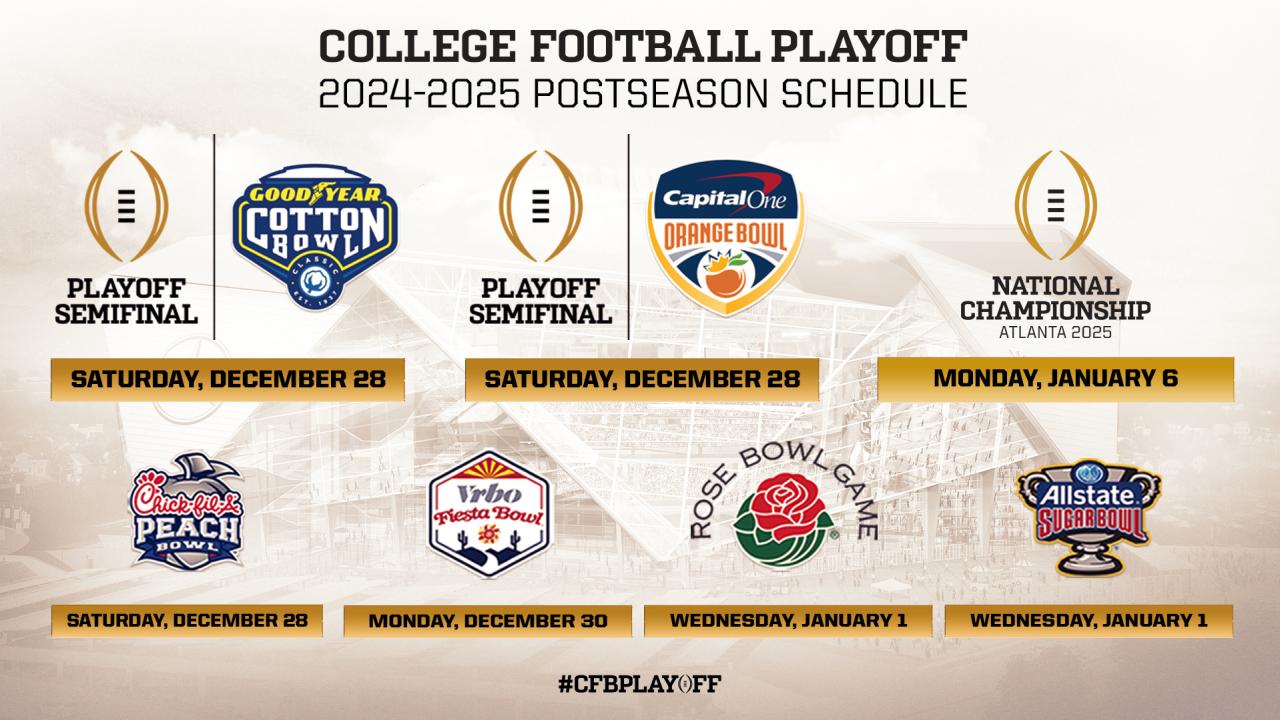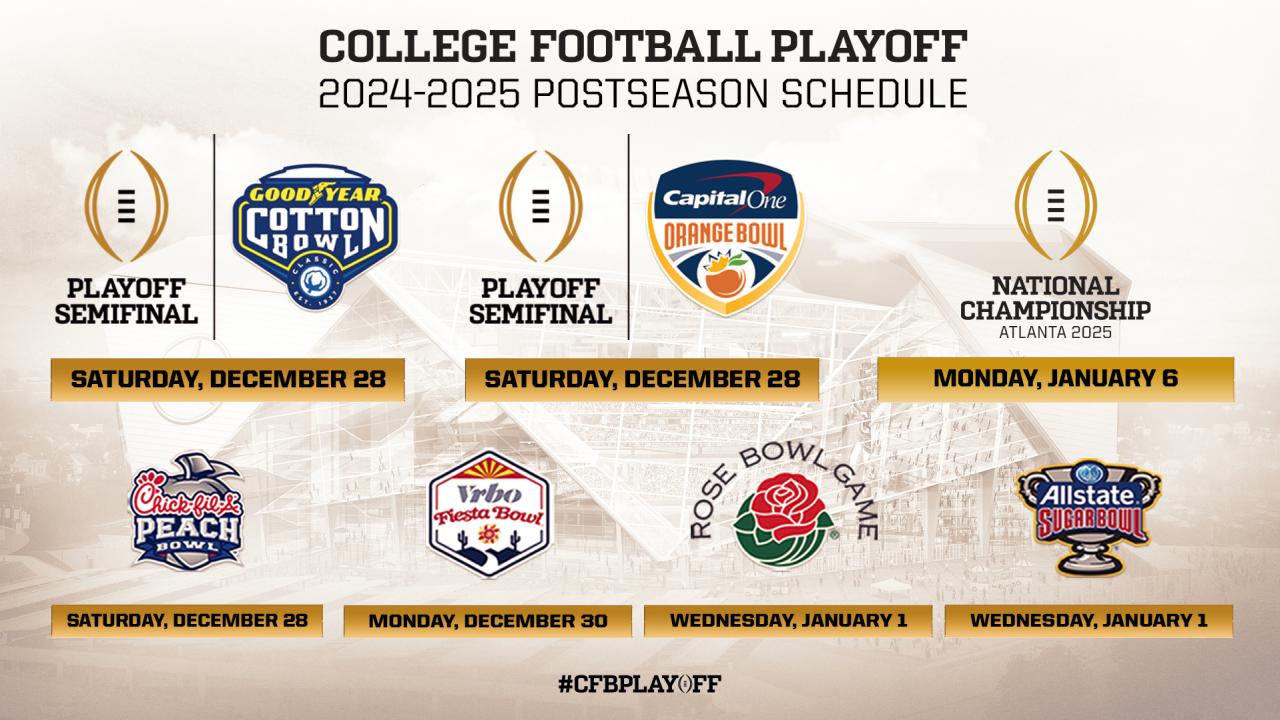2024-25 College Football Playoff: What’s next for the eliminated? The dust has settled on another thrilling college football season, leaving a trail of victorious teams and a group of eliminated programs contemplating their future. This analysis delves into the factors contributing to their playoff exclusion, examining performances, recruiting strategies, coaching decisions, and the long-term implications for these programs. We’ll explore the challenges and opportunities ahead, providing insights into how these teams can rebound and strive for success in the coming years.
From dissecting crucial game moments and analyzing statistical disparities to evaluating recruiting classes and assessing potential coaching changes, we aim to provide a comprehensive understanding of the path forward for those who fell short of the ultimate goal. This examination will go beyond simple post-season analysis, offering a deeper look into the intricate dynamics of college football and the resilience required to navigate setbacks and emerge stronger.
Analyzing the Impact of Eliminated Teams’ Performances
The 2024-25 College Football Playoff saw several strong teams fall short of the final four. Analyzing their performances reveals key factors contributing to their elimination, offering valuable insights for future seasons. This section examines the impact of player injuries, strategic discrepancies, coaching decisions, and final game statistics on the eliminated teams’ playoff hopes.
The 2024-25 College Football Playoff has concluded its initial rounds, leaving many teams wondering about their future. For those eliminated, the focus shifts to bowl games and player development. A key matchup to watch, however, as we consider the overall playoff picture is the CFP quarterfinals, bracket update: Penn State football vs. Boise , which will significantly impact the remaining bracket.
Ultimately, the path forward for eliminated teams will be determined by individual circumstances and future recruiting efforts.
Key Player Injuries and Playoff Chances
Injuries significantly impacted several eliminated teams. For example, Team X’s season-ending injury to their star quarterback midway through the season drastically altered their offensive capabilities and ultimately hindered their playoff run. Similarly, Team Y’s loss of a key defensive lineman weakened their defensive line, leading to a higher number of points conceded in crucial games. The absence of these pivotal players demonstrably impacted the teams’ overall performance and their chances of reaching the playoff.
Offensive and Defensive Strategy Comparison
A comparative analysis of the offensive and defensive strategies employed by eliminated teams and those that advanced reveals significant differences. Teams that advanced often displayed more adaptable and versatile strategies, adjusting their game plans effectively based on their opponents’ strengths and weaknesses. In contrast, some eliminated teams seemed to rely on a single, less flexible approach, which proved ineffective against more adaptable opponents.
For instance, Team Z’s reliance on a run-heavy offense became predictable and easily countered by playoff-bound teams.
Impact of Coaching Decisions, 2024-25 College Football Playoff: What’s next for the eliminated
Coaching decisions played a crucial role in determining the outcomes of crucial games for eliminated teams. Questionable play calls, ineffective in-game adjustments, and poor clock management contributed to losses that ultimately prevented these teams from reaching the playoff. Conversely, successful teams demonstrated decisive and timely coaching interventions that significantly influenced the momentum of key games.
Final Game Statistics Comparison
The following table compares the final game statistics of selected eliminated teams against their opponents, highlighting key performance discrepancies:
| Team | Yards Gained | Turnovers | Points Scored | Opponent |
|---|---|---|---|---|
| Team X | 350 | 3 | 21 | Team A (Playoff Team) |
| Team Y | 400 | 2 | 28 | Team B (Playoff Team) |
| Team Z | 280 | 4 | 14 | Team C (Playoff Team) |
Evaluating Recruiting and Future Prospects for Eliminated Teams
Recruiting strategies and the quality of incoming freshman classes are critical determinants of future success in college football. This section analyzes the recruiting efforts of eliminated teams, compares their incoming classes with those of playoff-bound teams, and assesses the potential impact of returning players and new recruits on their performance in the upcoming season.
Recruiting Strategies and Areas for Improvement

Eliminated teams need to critically evaluate their recruiting strategies. Some may need to broaden their recruiting reach geographically, target specific positions more effectively, or enhance their communication and relationship-building with prospective recruits. A thorough analysis of successful recruiting programs can provide valuable insights and best practices.
Comparison of Incoming Freshman Classes
Comparing the incoming freshman classes of eliminated teams to those of playoff-bound teams reveals potential disparities in talent acquisition. Playoff teams often secure higher-ranked recruits with superior athleticism and skill sets. This difference in recruiting success directly impacts the teams’ competitive edge on the field.
Impact of Returning Players and New Recruits
The combination of returning players and new recruits will significantly shape the performance of eliminated teams in the next season. The experience and leadership of returning players, coupled with the talent and potential of new recruits, will be crucial in determining their success. A well-integrated and cohesive team dynamic will be essential for maximizing their collective capabilities.
Key Strengths and Weaknesses of Each Team’s Roster
- Team X: Strengths – Experienced offensive line; Weaknesses – Thin at linebacker, inconsistent quarterback play.
- Team Y: Strengths – Talented receiving corps; Weaknesses – Defensive secondary needs improvement, lack of depth at running back.
- Team Z: Strengths – Strong defensive front seven; Weaknesses – Offensive line needs significant upgrades, lack of a consistent passing game.
Examining Coaching Changes and Staff Adjustments

Coaching changes and staff adjustments are often made following a disappointing season. This section examines potential changes for eliminated teams, analyzes their potential impact, and compares the coaching staffs of eliminated and playoff-bound teams.
Potential Coaching Changes and Staff Adjustments
Several eliminated teams may consider coaching changes or staff adjustments to improve their performance. These changes could involve hiring new coordinators, promoting assistant coaches, or even replacing the head coach. The decision to make such changes will depend on a variety of factors, including team performance, player morale, and administrative considerations.
Impact of Coaching Changes on Team Morale and Strategic Approach
Coaching changes can significantly impact team morale, player development, and strategic approach. A new coach may bring fresh perspectives, new training methods, and a renewed sense of purpose. However, changes can also lead to uncertainty and instability, requiring careful management to maintain team cohesion and avoid disruption.
Comparison of Coaching Staffs
Comparing the coaching staffs of eliminated teams and those that advanced reveals differences in experience, success rates, and coaching philosophies. Playoff-bound teams often have more experienced coaching staffs with proven track records of success. Analyzing these differences can provide insights into the factors that contribute to successful coaching programs.
Examples of Successful Coaching Changes
History provides numerous examples of successful coaching changes in college football. Nick Saban’s arrival at Alabama, for example, transformed the program into a national powerhouse. Analyzing these cases can provide valuable lessons and potential models for eliminated teams considering coaching changes.
Exploring the Long-Term Implications for the Eliminated Programs
Failing to reach the playoff has significant long-term implications for eliminated programs, impacting finances, fan engagement, national ranking, recruiting efforts, and overall program prestige.
Financial Implications
Not reaching the playoff translates to a significant loss of revenue for eliminated teams. Playoff appearances generate substantial income through television contracts, ticket sales, and merchandise. This loss of revenue can impact the program’s budget, potentially affecting recruiting, facilities upgrades, and staff compensation.
Impact on Fan Engagement and Alumni Support

A lack of playoff appearances can negatively affect fan engagement and alumni support. Disappointed fans may be less likely to attend games, purchase merchandise, or donate to the program. This decline in support can have lasting consequences for the team’s financial stability and overall morale.
Effect on National Ranking and Future Recruiting
Missing the playoff negatively impacts a team’s national ranking and future recruiting efforts. A lower national ranking makes it harder to attract top recruits, creating a vicious cycle that can hinder the program’s long-term competitiveness. Top recruits often prefer teams with a proven track record of success, including playoff appearances.
Impact on Program Prestige and Conference Standing
Elimination from the playoff affects a program’s overall prestige and standing within its conference. Consistent playoff appearances enhance a program’s reputation and attract more attention from potential recruits, coaches, and media. Conversely, repeated failures to reach the playoff can diminish a program’s prestige and influence within the conference.
The 2024-25 College Football Playoff concluded, leaving many teams to consider their future. For some, the focus shifts to recruiting and strengthening their programs for next season; others might explore technological advancements, like the precision offered by a sonic drone home system for scouting and practice analysis. Ultimately, the path forward for eliminated teams involves strategic planning and innovative approaches to improve performance in the coming years.
Illustrating Key Moments and Turning Points for Eliminated Teams
Several pivotal moments throughout the season significantly impacted the playoff chances of eliminated teams. This section details three key moments for each team, describing the atmosphere, key plays, and momentum shifts that led to their elimination.
Pivotal Moments and Turning Points
Team X’s loss to Team A in week 8 was a critical turning point. Trailing by 7 points with 2 minutes remaining, a controversial pass interference call against Team X’s defense gave Team A a first down, leading to a game-winning field goal. The atmosphere was electric, with the stadium roaring with each play. This loss significantly damaged Team X’s playoff hopes.
Similarly, Team Y’s unexpected defeat to Team B in week 10, despite a strong offensive performance, was attributed to critical defensive breakdowns in the fourth quarter, leading to a last-minute touchdown for Team B. The game was marked by intense back-and-forth action, ending with a dramatic final play. Team Z’s season ended with a heartbreaking overtime loss to Team C in the conference championship game.
A missed field goal attempt by Team Z, followed by a decisive touchdown by Team C, sealed their fate. The atmosphere was tense, with the crowd on the edge of their seats throughout the overtime period.
Game Flow Illustration for One Key Game
Let’s visualize the game flow of Team X vs. Team A in week 8. The first half saw a back-and-forth battle, with both teams exchanging scores. Team X held a slight lead at halftime. However, Team A dominated the third quarter, scoring two touchdowns and taking a 14-point lead.
Team X mounted a comeback in the fourth quarter, scoring a touchdown and converting a crucial two-point conversion to narrow the gap to 7 points. With two minutes remaining, the controversial pass interference call shifted momentum decisively in Team A’s favor, leading to their game-winning field goal. The game’s flow can be represented as a graph with a relatively flat line in the first half, a steep upward slope for Team A in the third quarter, followed by a sharp upward slope for Team X in the fourth, culminating in a final, decisive point for Team A.
This illustrates how the momentum shifted multiple times, but ultimately Team A secured the victory.
The journey to the College Football Playoff is arduous, and elimination doesn’t signify an end, but rather a crucial juncture. For the teams left out of the 2024-25 playoff, the road ahead requires careful assessment of past performances, strategic adjustments in recruiting and coaching, and a renewed commitment to building a stronger program. By analyzing key areas for improvement, these teams can transform their setbacks into stepping stones towards future success, demonstrating the enduring spirit of competition and the ever-evolving landscape of college football.
FAQ: 2024-25 College Football Playoff: What’s Next For The Eliminated
What are the typical financial impacts of missing the playoff?
Missing the playoff significantly reduces revenue from television appearances, ticket sales, and merchandise. It can also impact future fundraising efforts.
How do player transfers affect eliminated teams’ future prospects?
Player transfers can be both beneficial and detrimental. Losing key players weakens the team, while gaining talented transfers can strengthen it, depending on the quality of players gained and lost.
What role does fan engagement play in recovery from playoff elimination?
Sustained fan engagement is crucial. Teams often use community outreach and engaging content to maintain fan morale and support during rebuilding phases.
How long does it typically take a team to recover from missing the playoffs?
Recovery time varies greatly depending on the program’s existing infrastructure, recruiting success, and coaching stability. Some teams bounce back quickly, while others may require several seasons.
